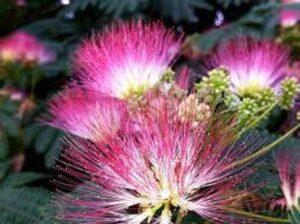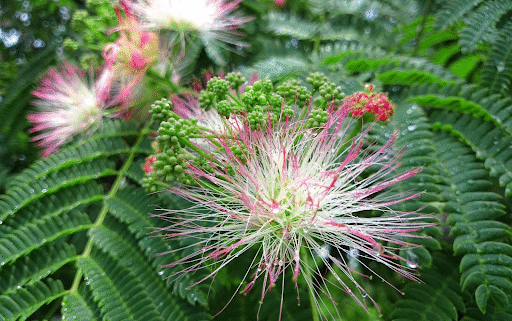Mimosa
Mimosa is a tree that is considered invasive in these parts. Native to East Asia, mimosa has a long history as a medicinal plant in Traditional Chinese Medicine, where it is named He-Huan, which means “Tree of Collective Happiness”. Read on to find out why this tree deserves our respect and appreciation despite its “invasive” tendencies.
 BOTANICAL NAME: Albizia julibrissin
BOTANICAL NAME: Albizia julibrissin
COMMON NAMES: Mimosa, Silk Tree, Sensitive Plant, Herbal Prozac, Collective Happiness Bark, Happiness Tree, He Huan Pi (Pinyin)
FAMILY: Fabaceae (Legume or Bean family)
PARTS USED: Flowers and Inner Bark
BOTANICAL DESCRIPTION: Fast growing, broad-crowned, short trunked tree that grows to 30ft. Leaves have a graceful, feathery appearance, with doubly compound leaflets, each containing 2-30 pairs of oblong leaflets (pinnules) .5 to 1 inch long, one side distinctly longer than the other. The leaves of some species of mimosa are sensitive to touch, curling inward with contact, and many fold up their leaves at night. Flowers are pink, silky, fluffy blooms. Around here these bloom May-August. The seeds that appear in late summer are flat, brown, dry, and shaped like pea-like pods, about 6” long.
GROWING/HARVESTING/PROCESSING: Commonly found growing throughout the Southern and Eastern regions of the United States, Albizzia is native to China, Persia, Korea and Japan. Plant prefers partial sun and moist but well-drained soil, however, will withstand drought and high winds and is quite resilient.
To start from seed, nick seed and drop in just boiled water and allow to soak overnight. Plant about ½” deep and keep in bright light and with even light and moisture conditions. Germination takes about 1 week. Seedlings should be placed into gallon pots and grown out for a year before transplanting to landscape.
Harvest flowers when newly opened in early summer. After flowers have been open for more than 2 days, they will start turning brown. Harvest inner bark in late winter or spring. Use older bark if possible as the inner portion of the bark is the most potent medicinally and older branches carry more inner bark.
ACTIONS AND PROPERTIES: Nervine, mood-enhancer, sedative, analgesic, vulnerary, relaxant, antimicrobial, anthelminthic
INDICATIONS: Both the bark (he huan pi) and the flowers (he huan hua) of Albizia are used as a calming sedative in Traditional Chinese Medicine. Categorized in the Chinese Materia Medica as a calming spirit herb, or a “shen tonic,” Albizia can soothe a troubled heart and mind. The bark is thought to “anchor” or ground the spirit, while the flowers lighten it.
The flowers and bark are valued for relieving insomnia, anxiety, stress, and depression. Its use was first documented in the Shen Nong Ben Cao (Divine Husbandman’s Classic of the Materia Medica), one of the oldest medicinal texts from China, during the 2nd century. It was described as a mood-enhancing, calming and heart-soothing herb. Chinese people traditionally recommend its use for anyone who is suffering from grief as a result of a severe loss. While the flowers tend to have more uplifting and mood enhancing properties, the bark is more sedative and “anchors” the heart and the spirit, both of which can be helpful when there is grief, sorrow, insomnia and anxiety. It is wonderful for anyone suffering from heart-ache, depression, anxiety, anger, irritability, bad dreams, phobias, paranoia, sleep disorders, and any kind of emotional distress.
Considering the proliferation of antidepressant drugs throughout the western world with their increasingly adverse effects, isn’t it wonderful that this tree grows in abundance and offers a safer and better alternative? Michael Tierra says albizzia offers a more profound effect in treating depression and anxiety than the two most commonly promoted herbs, St. John’s Wort (Hypericum perforatum) and Kava (Piper methysticum) and should be more widely used. Albizzia is thought to enhance all aspects of neurotransmitter secretion and regulation. Like all herbs, mimosa has multiple chemical constituents working on a number of pathways and mechanisms, giving it a pleotropic effect (more than one effect).
Depression is a multifactoral syndrome with various underlying pathological mechanisms, and conventional antidepressants with single targets are often inadequate for effective treatment, while herbs like albizia have been shown to exert an antidepresasnt-like effect through various mechanisms, acting on multiple pathological factors across different systems (Huang B. et al).
Albizzia is also used for amnesia, poor memory, and agitation due to constrained emotions- especially when accompanied by epigastric pain and feelings of pressure in the chest. Secondarily, the bark is regarded as one of the most important herbs for the treatment of external trauma, contusions, and injuries. It promotes blood circulation, reduces pain and swelling, promotes the regeneration of flesh and facilitates the healing of bone fractures. (Michael Tierra)
Ayurvedic uses include bronchitis, asthma, allergic disorders, leprosy, eczema, as an anti-inflammatory agent, and worm infestation.
CONTRAINDICATIONS: Because of its blood moving properties it may be contraindicated in pregnancy and breastfeeding, although I could find no definitive contraindications in any of my sources. Best to avoid during pregnancy at least.
As mentioned from www.HearthsideHealing.com: “Please note that there are several western herbalists who have noted that Albizia has caused people susceptible to mania to become manic. This was surprising to me as there is no evidence of this in modern or traditional Chinese herbal literature. In fact, it is one of the most commonly prescribed herbs for insomnia, disturbed and vivid dreaming in Chinese medicine. But notable herbalists David Winston, Thomas Easley and Janet Kent have all reported this to me so I must make mention if it here.” I interpret this caution as a reminder to not use the herb unless it is indicated. Mania is not one of the indications for mimosa. Other emotional disturbances such as melancholy, grief and restlessness are indications for this plant. When we use herbs, we look to their energetics and indications to guide us. If someone does not have the symptoms described above, they probably don’t need this plant. If someone alternates between depression and mania, they would only need to use the mimosa when they are in the depressed state and discontinue when the mania sets in (maybe switch to skullcap and passionflower for those periods).
I have also not been able to find any observed herb-drug interactions. Some sources say that there is a theoretical contraindication with mimosa for people who are taking prescription anti-depressants, but I have not found any validation for this in terms of studies or case reports. So, I would still feel comfortable using this concurrently with anti-depressant medications, but I would start with small doses and ask my client to tune into their body awareness monitor any changes to mood, energy, sleep, etc. Because mimosa has multiple mechanisms of action and is not working on a single target or pathway, it is unlikely that mimosa would cause a severe interaction.
PREPARATION AND DOSAGE: Soluble in alcohol, water
Dried bark: 9-30 g/day; Flowers: 3-9 g/day (Foster & Chongxi)
Tincture: Freshly dried flowers (1:2, 50% alcohol); Dried bark (1:5, 50% alcohol); 10 drops to 5 ml 1-4x/day.
Decoction of bark: As it is fairly unpleasant, this is not the best tasting infusion. To improve the taste, add other herbs which decoct well and benefit the formula’s intention.
Can also infuse into honeys, oils, or use in an antimicrobial mouthwash.
COMBINATIONS:
- Combine with Ghost Pipe, Oat Tops and/or Lemon Balm for deep grief
- Combine with Goldenrod, Nettles, and Plantain for seasonal allergic relief
HOMEOPATHIC USE: Good for rheumatism, stiff joints, lancinating pains in back and limbs. Swelling of ankles, legs tremble. (Boericke)
FLOWER ESSENCE USE: I embrace childlike wonder. Helps regain playfulness and childlike innocence while remaining grounded. This Essence is wonderful for Dreamwork. (Brigd’s Way)
ETHNOBOTANY/FOLKLORE/HISTORY: German scientists assert that mimosa tree bark is part of the heavily guarded Coca Cola recipe, a concoction that has been making people happy for decades! (1999-2001- Pulse Media International)
Phyllis Light says mimosa is used in much the same way peach leaf is used in traditional Appalachian herbalism. She also suggests using mimosa to break addictions such as sugar.
Mimosa is also known in the East to “promote family affection & harmony” (Holmes)
REFERENCES:
- The Modern Herbal Dispensatory, Thomas Easley & Steven Thorne
- hearthsidehealing.com – Mimosa – The Happiness Tree
- New Manual of Homeopathic Materia Medica with Repertory, William Boericke
- Albizia Spirit Essence – Brigid’s Way
- Herbal Emissaries- Bringing Chinese Herbs to the West- by Steven Foster & Yue Chongxi
- Jade Remedies: A Chinese Herbal Reference for the West, Volume 1- by Peter Holmes
- Huang B, Wu Y, Li C, Tang Q, Zhang Y. Molecular basis and mechanism of action of Albizia julibrissin in depression treatment and clinical application of its formulae. Chin Herb Med. 2023 Mar 15;15(2):201-213. doi: 10.1016/j.chmed.2022.10.004. PMID: 37265761; PMCID: PMC10230641. https://pmc.ncbi.nlm.nih.gov/articles/PMC10230641/
*** These statements have not been reviewed by the FDA. This article is for educational purposes only and is not intended to diagnose, treat, cure or prevent any disease ***




